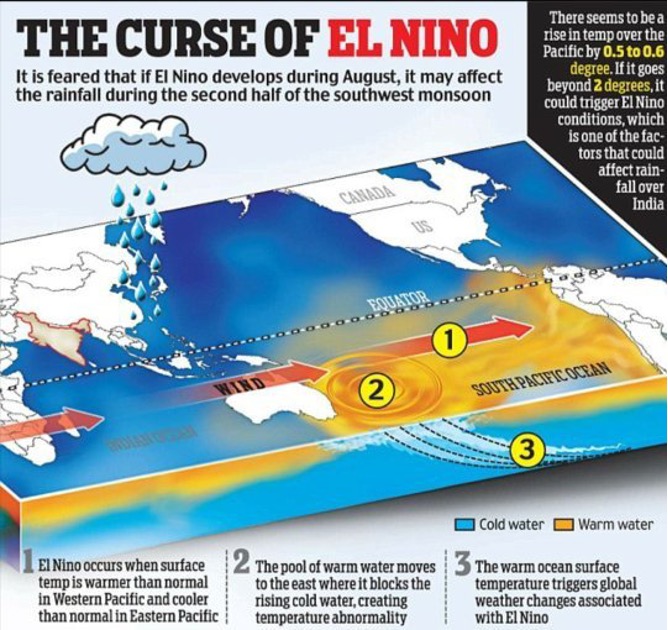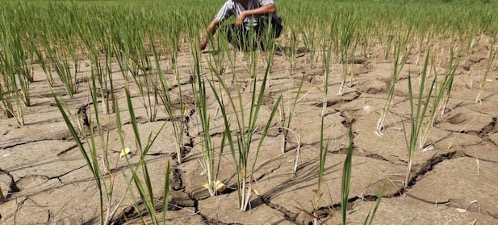The exceptional warming of surface waters in the eastern tropical Pacific Ocean is referred to as El Nino, a climate pattern. El Nino is the “warm phase” of the El Nino-Southern Oscillation (ENSO), a more extensive phenomenon. The unusual chilling of the area’s surface waters is referred to as La Nina or the “cool phase” of ENSO. The Southern Oscillation represents the fluctuations in ENSO’s atmospheric component, whilst El Nino and La Nia are thought to be its ocean components.
Each El Nino is distinct in its strength and course. They can happen every two to six years and do not happen regularly. As a result, the atmospheric circulation is altered, altering the patterns of rainfall and causing temperature fluctuations around the world.
El Nino possibly weakens the southwest monsoon season, which is still relied upon by the majority of farmers and contributes to roughly 70% of India’s annual rainfall. Hurricane-like El Nino occurrences are frequently associated with less effective monsoons over the Indian subcontinent.
Impact of El Nino on Indian Monsoons
Less rain may fall than usual if an El Nino weather pattern forms during the monsoon season of June to September, which has a 90% chance of doing so.
In the past, India has suffered below-average rainfall during the majority of El Nino years, occasionally resulting in severe drought that devastated crops and compelled officials to restrict the export of some food grains.
Trade winds from the Northern and Southern Hemispheres meet in the Intertropical Convergence Zone (ITCZ), a belt of low-pressure areas around the equator. When El Nino occurs, the ITCZ’s location might move eastward, causing rain to concentrate over the eastern and central equatorial Pacific, instead of reaching India.
Experts projected that another cyclone would form closer to the start of the monsoon as a contributing factor. This occurs when the monsoon’s weak or delayed beginning leads to favourable atmospheric and oceanic conditions for cyclone formation.
Due to the difference in warmth between the Indian subcontinent and the surrounding ocean, the Indian Ocean is essential to the dynamics of the monsoon. The Indian Ocean typically experiences colder sea surface temperatures during El Nino episodes. El Nino delayed warming of the Indian Ocean prevents the formation of low-level temperature gradients, which are essential for the beginning of the monsoon. As a result, it takes longer for the monsoon winds to intensify and adopt their typical seasonal pattern.

El Nino Influencing Indian Agriculture due to the Occurrence of Droughts
Changes in sea surface temperature (SST) in both the equatorial Pacific and Indian Oceans are associated with changes in the interannual variability of Indian summer monsoon rainfall (ISMR. Most El Nino events have been very dry, ENSO phenomena have a significant impact on summer monsoon rainfall in India. However, the opposite is not always true. In the past, El Nino was closely associated with drought in India, although this association has diminished in recent times.
Most of the El Nino scenarios are characterized by periods of weak rainfall, high temperatures in India and possible drought during El Nino events that could hamper India’s crop production and water supply.
Moreover, El Nino results in deficient rainfall which reduces the production of winter crops like rice, sugar, cotton, sesame seeds etc. Thus, resulting in higher prices and lower GDP due to huge subsidies, contributing to the agriculture sector to the Indian economy.
El Nino may also have an impact on the types of crops that are sown during a specific season. To lessen the hazards associated with reduced rainfall during El Nino years, farmers may switch to less water-intensive or drought-tolerant crops, such as pulses or oilseeds.

Water is essential for the cultivation of sugarcane, therefore any shortage brought on by El Nino may be damaging to the crop. Reduced rainfall may cause sugarcane fields to experience water stress, which will impact the crop’s growth and sucrose content. The sugar industry may be impacted, as a result of decreasing sugar production.
Lentils, chickpeas, and pigeon peas are examples of pulses that are frequently regarded as more drought-tolerant plants. Farmers may decide to grow pulses rather than water-intensive crops like rice or sugarcane during El Nino years when monsoon rainfall is below average. However, extended dry spells can still have a deleterious impact on pulse crops, lowering their potential output.
It’s crucial to remember that the effects of El Nino on Indian agriculture might change from year to year, and rely on the intensity and length of the event as well as local circumstances. Other climatic and regional conditions can also have an impact on agricultural results, even if El Nino normally hurts Indian agriculture
Diminishing the Economic Sector
El Nino affects the climate and raises the temperature, which can further impede rainfall. The Reserve Bank of India has additionally cautioned that this difficulty may affect yield, which might cause the inflation rate to rise above 8.5% and lead to an increase in interest rates, which may have an effect on the investment cycle of India Inc. and slow the rate of growth.
India has an agrarian economy, thus a successful monsoon is essential for its crops because most of its farmland is still rain-fed. El Nino’s reduced rainfall can result in crop failure, water scarcity, an increase in food costs, and decreased yields, which lowers farmer income and impacts millions of people.
During the wheat harvest, a big obstacle to India’s food security presents itself. Although the rabi seeding was encouraging, if early rain occurs before harvest as predicted by El Nino experts, it could drive up the price of wheat. Malnutrition and food inflation would result from a further 20% drop in production.

The agricultural sector in India is highly vulnerable to El Niño. Reduced monsoon rainfall and drought conditions can lead to lower crop yields, affecting farmers’ incomes and overall agricultural productivity. This can result in higher food prices, reduced export potential, and increased dependence on imports, impacting the economy as a whole.
According to statistics collected over the past 50 years, an episode of a severe or moderate El Nino has typically resulted in deficient or drought-like conditions in India, which hurt agricultural productivity and are correlated with slower GDP development.
Written by Neha Gandhi
Edited by Kushi Mayur
